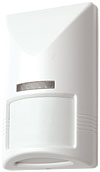
For many years, one of the most common solutions for saving energy has been to “turn out the lights and dial down the thermostat.” It’s a given that unoccupied space is one of the biggest energy drains in a building. Yet occupants continue to heat and cool rooms even when there are prolonged vacancies - perhaps hours or days. Now that is energy waste.
One of the technologies that has popped up in recent years is the motion (occupancy) sensor - room sensors that automatically detect the presence of an occupant and adjust lighting or comfort conditions while the room is in use. This technology is designed to save energy costs beyond the traditional options of turning off lights and dialing down a thermostat.
But can this technology find a place in the HVAC contracting world? Very likely, if it hasn’t already.
“As part of an HVAC energy management system, occupancy sensors enable facility managers to automatically control HVAC operation based on room occupancy,” said Nick Stevenson, product marketing manager, Peco Automation and Controls. “If the room is physically occupied, then the system will allow occupants to control the climate. Once a room is vacant, the system will automatically set back the HVAC equipment to reduce energy consumption and equipment wear. Thus, no energy is spent to climate control an empty room.”
Knowing that, what are some ways that HVAC contractors can integrate motion sensor technology into their present product mix? “Integrating motion sensors is still somewhat limited in terms of dynamic in the field solutions,” said Randy L. Clayton, C.E.M., C.E.A., Autani Corp. “However, there are several thermostats on the market today that include motion sensors embedded in the unit, and this can be a solution when the thermostat is in a small, open room. But in larger, odd-shaped, or partitioned areas, occupancy detection generally requires remote sensor capability.
“Marketing this technology to their customer base is easy, especially in today’s green-minded environment. The fact is, most programmable thermostats are ineffective when schedules are properly set simply because occupancy is difficult to schedule. And many more are not scheduled properly. Just one hour of HVAC run time has a lot more meaning than it did in the past. So the marketing should be focused on the energy control aspects of motion sensors, coupled with reduced run times and fewer repairs.”
Tom Jackson, CEO of Jackson Systems LLC, agrees that marketing sensor-based control fits well with the contractor’s efforts to market green.
“I believe it is easy for the customer to understand that if they are not occupying that space, why have the lights or the heating and cooling on?” he said. “Because it is simple to understand its benefits, it should be fairly straightforward for a contractor to market.”

COMMERCIAL BUILDINGS
According to sources interviewed for this article, motion sensor technology - for the time being - is more suited for commercial rather than residential buildings. But that eventually may change. “We believe the technology has a way to go in the residential space,” said Clayton. “Most homes are a collection of small rooms, which means more controls and ultimately more cost.”
Leveraging these controls for other solutions - such as security and lighting - can help in the consumer’s mind, but this still has more of a high-end, automation bend to it.
“In the commercial space, you typically have fewer small spaces that are highly occupied. Even when there are many offices, you can place sensors in strategic areas simply because of the traffic volume. So the cost to savings ratio is very good.”

Stevenson said his company makes sensors that are made for the commercial market. “Passive infrared (PIR) sensing technology and intelligent logic control software allow our sensors to verify the occupancy status of rooms,” he said. “These sensors are ideal for commercial properties such as hotels, resorts, schools, military lodging, commercial offices, and other multi-room facilities. The sensors are a small investment with a great ROI from energy savings. In addition to the motion, Peco also offers door and window switches which, when open, disable the HVAC system automatically.”
Jackson noted that while motion sensors are primarily used in commercial buildings, there are several applications for HVAC contractors in the light commercial market.
“In recent years, there have been several companies that have introduced products geared toward smaller facilities (churches, small retail centers, etc.) that are using motion sensors to control lighting and occupied/unoccupied functions of the HVAC system,” he said.
“I believe we are still a few years away before we see it used regularly in residential applications. So if contractors want to enter this market, they really need to focus on the commercial side of the business.”
Clayton agrees, citing the common wired thermostat, which is a staple in residential buildings. “Some wired solutions exist that provide remote sensors to a single thermostat, but these are often difficult to configure and deploy,” he said. “Wireless management solutions provide for an integrated and flexible control system that leverages occupancy inputs across multiple HVAC units in a simple-to-deploy package.
“From a technology perspective, PIR and ultrasonic motion detection are well vetted solutions. It becomes less of a technology question and more of what makes sense. You can find some homes where it does make sense, but most commercial spaces can benefit from the solution.”
Making sense is the key. “Occupancy sensors are an inexpensive and easy-to-implement solution to reduce HVAC energy consumption,” said Stevenson.
For more information, visit www.pecomanufacturing.com, www.autani.com, or www.jacksonsystems.com.
Publication date: 01/24/2011

Report Abusive Comment